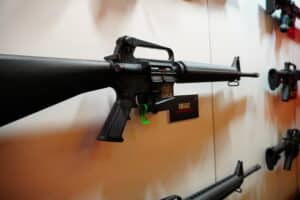Democratic lawmakers are taking another shot at banning a wide swath of semi-automatic firearms and ammunition magazines. But this time, they’re taking a different approach.
Senators Angus King (I., Maine) and Martin Heinrich (D., N.M.) introduced the Gas-Operated Semi-Automatic Firearms Exclusion (GOSAFE) Act on Thursday. Shedding the traditional moniker of “assault weapon ban” that previous iterations of the sort have adopted, the bill instead trains its focus on, as its name suggests, “gas-operated” firearms.
The end result of the legislation would be roughly in line with traditional assault weapon and magazine ban bills, but the route to get there is unique and, at points, quite odd. It’s also almost certainly doomed to fail until at least the 2024 elections, given the current balance of power in the House and Senate. Despite this, it has the backing of nearly every major gun control organization in the country and the high-profile sponsorship of three U.S. Senators who, to this point, have never sponsored an assault weapon ban publicly before.
Therefore, the approach could prove influential if it marks a turning point for advocates looking for new ways to repackage a long-desired policy priority. For that reason, it’s worth looking in closer detail at what the GOSAFE Act does and how it gets there.
Semi-Automatic Firearms and Ammo Magazines
The marquee feature of the bill is its attempt to go after semi-automatic rifles and detachable ammunition magazines with a certain capacity.
Its restrictions on magazines are relatively straightforward. The proposal would ban the sale, manufacture, transfer, and possession of “large capacity ammunition feeding devices,” defined as any detachable device capable of holding more than ten rounds of ammunition. Existing owners of affected magazines would be allowed to maintain possession of them, but they would be prohibited from transferring them to anyone who is not an immediate relative.
However, the bill’s firearm restrictions are less clear-cut. According to its text, the measure would ban the sale, manufacture, transfer, and possession of “gas-operated semi-automatic firearms” that can accept detachable magazines. The bill’s text defines it as any semi-automatic firearm that “harnesses or traps a portion of the high-pressure gas from a fired cartridge to cycle the action,” which is fairly straightforward.
But its definition of gas operated is much more convoluted.
The bill lists several common gas systems incorporated into modern firearms by name that would be banned by the bill, including long and short-stroke pistons, direct impingement, and hybrid systems. But it also lists operating systems generally not considered “gas operated” by gun enthusiasts, such as direct blowback or recoil-operated systems, under the “gas operated” definition. As with the magazine provision, previous owners of gas-operated semi-automatic firearms would be allowed to keep them. But they can only transfer them to immediate family members.
It also prohibits the sale, manufacture, transfer, and possession of any “combination of parts” that, if assembled, could become a gas-operated semi-automatic firearm or modify a non-gas-operated firearm into one.
The exemptions to the ban are more clarifying about the ban’s intent than the actual banned firearm language itself. According to the text of the measure, firearms that are not considered illegal “gas-operated semi-automatic firearms” include guns chambered to shoot rimfire cartridges that are .22 caliber or lower, semi-automatic shotguns of all kinds, recoil-operated handguns, any rifle or shotgun with a permanently fixed magazine capable of holding ten rounds or less, and any handgun with a permanently fixed magazine of 15 rounds or less. It also specifically exempts several types of firearms from its semi-automatic gun ban that aren’t even semi-automatic in the first place, including single-shot weapons, muzzleloaders, pump actions, lever actions, bolt actions, and revolvers.
As a result, the bill takes a circuitous path to arrive at a similar—though noticably more restrictive—place most assault weapon bans arrive at. It’s ultimately a ban on all semi-automatic rifles and some semi-automatic handguns with detachable magazines.
The new bill and traditional bans both cut off sales of rifles, like the AR-15. But the new bill would also ban some that survive other bans, such as the Ruger Mini 14. As with assault weapons bans, the new bill exempts most popular semi-automatic handguns, such as common Glocks and Sigs. But the new proposal would ban all semi-automatic pistols that aren’t “recoil operated,” such as the new Laugo Alien or even Hi-Point Yeet Cannon.
“Rate of Fire” Modifications
The bill would also ban certain firearm modifications. It would ban the sale, manufacture, transfer, and possession of a “manual, power-driven, or electronic device,” that, when attached to a semi-automatic firearm, “materially increases the rate of fire of the firearm” or “approximates the action or rate of fire of a machinegun.” It does the same for any semi-automatic firearm modified to meet the aforementioned criteria.
Notably, this prohibition applies to all semi-automatic firearms, not just those newly designated by the bill as illegal “gas-operated” semi-automatics. This provision is aimed at controversial gun accessories like bump stocks, forced-reset triggers, or “Glock switches.” However, the bill fails to define the thresholds of when a modification “materially increases the rate of fire of the firearm,” so as to become illegal, leaving open the possibility that common upgrades like lighter precision triggers or heavier recoil springs could qualify.
Gun Buyback
The bill would establish an optional buyback program through “Edward Byrne Memorial Justice Assistance Grant (JAG) funding” to compensate individuals who voluntarily turn over their grandfathered non-transferrable firearms and ammunition magazines. But it doesn’t lay out how a buyback would work or what compensation would be offered.
Empowering the Attorney General
As with many facets of federal firearms law, the GOSAFE Act would direct the executive branch to work out many of the details needed for the law to take effect. Once passed, the measure would give the Attorney General and the ATF 180 days to compile, publish, and begin updating a list of newly banned gas-operated semi-automatic firearms on the Federal Register.
The AG’s office would then be tasked with establishing an application process for licensed gun manufacturers to get any future semi-automatic firearm designs approved before they can be sold to the public. Manufacturers must include details about the firearm’s specifications and operations, a physical sample of the firearm, any patent application, marketing materials, plans, an explanation for why the gun would not meet the gas-operated semiautomatic firearm prohibitions, and any other information requested during the application process. The bill would give the AG’s office 240 days to approve or deny a semi-automatic design application.
Once added to the list, firearms by make and model would only be eligible for removal by the AG upon a standard of clear and convincing evidence that it does not fall under the definition of a gas-operated semi-automatic firearm. The bill also creates a private cause of action that would allow “any person” to challenge the removal of a firearm from the banned list in court.
The Bottom Line
Ultimately, the GOSAFE Act represents a new approach to several longtime policy goals. With that new branding, however, comes plenty of added stringency.
If passed, it would functionally ban the sale and future possession of all semi-automatic rifles with detachable magazines, ban any semi-automatic handgun that isn’t recoil operated, limit all detachable magazines to ten rounds of capacity, and leave open the possibility that gun owners could be prosecuted for decreasing the pull weight on their firearms with aftermarket triggers. It would also put the Attorney General in charge of personally approving or denying nearly all future semi-automatic firearm offerings.
Don’t expect the new packaging to be any better received among gun-rights advocates.






